Infrared therapy speeds up your muscle recovery by triggering several powerful healing mechanisms in your body. When the light penetrates your muscle tissue, it stimulates your mitochondria to produce more ATP (cellular energy), boosting your body's natural repair processes. You'll experience increased blood flow and oxygen delivery to damaged areas, while inflammation and pain decrease through reduced pro-inflammatory molecules. The therapy also enhances cell-to-cell communication and activates stem cells for faster tissue regeneration. It's like giving your muscles a natural energy boost that cuts recovery time by up to 60%. Discover how to maximize these benefits through ideal treatment timing and protocols.
The Science Behind Light Therapy
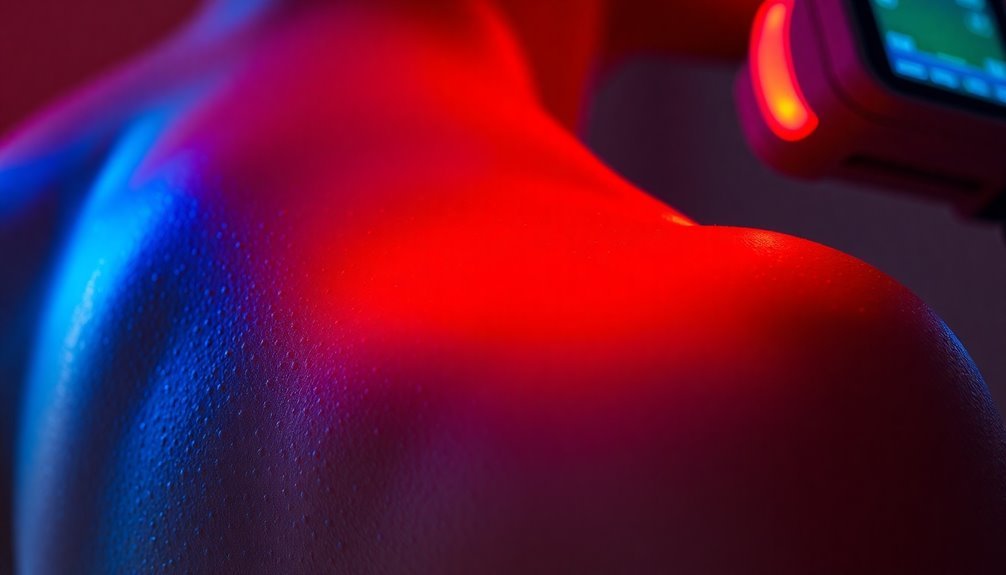
Through advances in photobiomodulation research, scientists have uncovered how infrared light therapy triggers powerful cellular responses in muscle tissue. When infrared light penetrates your muscles, it stimulates your cells' mitochondria to produce more ATP – the primary energy source your cells need for repair and function.
This boost in cellular energy kicks off a cascade of beneficial effects throughout your muscle tissue. You'll experience reduced oxidative stress as your cells begin producing more antioxidants, which help protect against cellular damage and inflammation. Athletes commonly use this therapy 3-4 times per week for optimal recovery results.
The therapy also enhances communication between your muscle cells, leading to better-coordinated tissue repair and function. What's particularly remarkable is how infrared light improves your blood circulation, delivering essential oxygen and nutrients to damaged areas while simultaneously reducing inflammation.
The biochemical mechanisms behind these effects are well-documented in clinical trials. Studies show that when you undergo infrared therapy, your muscles experience a significant decrease in markers of damage, such as creatine kinase.
This scientific evidence explains why you'll recover faster and experience less muscle soreness when using infrared therapy compared to traditional recovery methods like cryotherapy.
Cellular Response to Infrared Light
Deep within your muscle cells, infrared light triggers a remarkable series of cellular responses that enhance healing and recovery. When infrared light penetrates your skin, it's absorbed by the mitochondria, your cells' powerhouses, stimulating increased production of ATP – the essential energy molecule your muscles need for repair and function.
Your cells respond to infrared exposure in multiple ways that accelerate recovery:
- ATP production surges, providing the necessary energy needed for muscle repair and regeneration while boosting overall cellular performance
- Inflammatory responses are naturally modulated as the light therapy reduces pro-inflammatory cytokines and increases anti-inflammatory molecules
- Blood flow improves through the formation of new capillaries, delivering more oxygen and nutrients to damaged tissues
- Antioxidant effects kick in, protecting your muscle cells from oxidative stress and supporting faster healing
This cellular response creates a cascade of healing effects that you'll notice through reduced muscle soreness, decreased inflammation, and faster recovery times. Using specific wavelengths between 800-850 nm, near-infrared light effectively penetrates deep into muscle tissue for optimal healing benefits.
The process works particularly well when you use infrared therapy both before and after exercise, as it primes your cells for peak performance and recovery.
Blood Flow and Muscle Healing
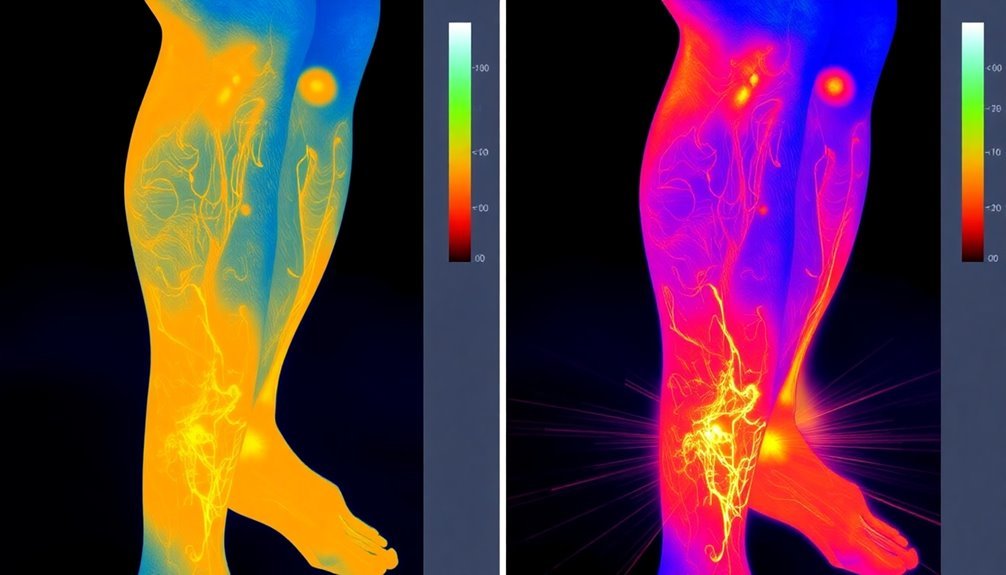
A steady flow of oxygen-rich blood serves as the cornerstone of muscle healing and recovery. When you undergo infrared therapy, the light penetrates deep into your tissues, causing your blood vessels to dilate and dramatically increasing circulation.
Your blood flow can surge from 5-7 quarts per minute to an impressive 13 quarts per minute, similar to what you'd experience during exercise. This process activates mitochondrial energy production in your muscle cells.
This enhanced circulation triggers a cascade of healing effects. You'll experience increased oxygen delivery to your damaged muscles as infrared light stimulates the release of nitric oxide, a compound that relaxes your blood vessels.
This boost in oxygen is essential for your cells' energy production and tissue repair through the Krebs Cycle.
The therapy's impact on inflammation is equally significant. As your circulation improves, you'll notice reduced muscle soreness and faster recovery times.
Your body's anti-inflammatory responses kick into high gear, helping to lower markers of muscle damage like creatine kinase. For athletes and fitness enthusiasts, this means you'll recover 1-3 days faster, maintain better muscle strength, and potentially achieve enhanced performance during your next workout session.
Mitochondrial Power Generation
Inside your muscle cells, mitochondria serve as microscopic powerhouses that drive recovery and regeneration. These tiny organelles produce ATP, the essential energy currency your muscles need to repair and rebuild.
When you're recovering from exercise or injury, your mitochondria kick into high gear, ramping up energy production through a process called oxidative phosphorylation. These organelles comprise 3-6% of muscle volume in healthy human tissue.
Near-infrared light therapy enhances your mitochondrial function in several ways:
- Boosts cytochrome C oxidase activity, improving cellular energy metabolism
- Increases the total number of mitochondria in your muscle cells
- Reduces oxidative stress during the recovery process
- Stimulates mitochondrial fission, helping to maintain healthy mitochondrial networks
Your mitochondria's efficiency directly impacts how quickly you'll bounce back from muscle strain or damage. Through ATP synthase, these organelles harness electron gradients to generate the energy needed for muscle regeneration.
They're also essential for supporting muscle stem cell expansion and differentiation, which are critical steps in the repair process. When your mitochondria function at their best, they create the perfect environment for muscle recovery by maintaining proper NAD+ levels and managing cellular energy demands throughout the healing process.
Inflammation Control Mechanisms
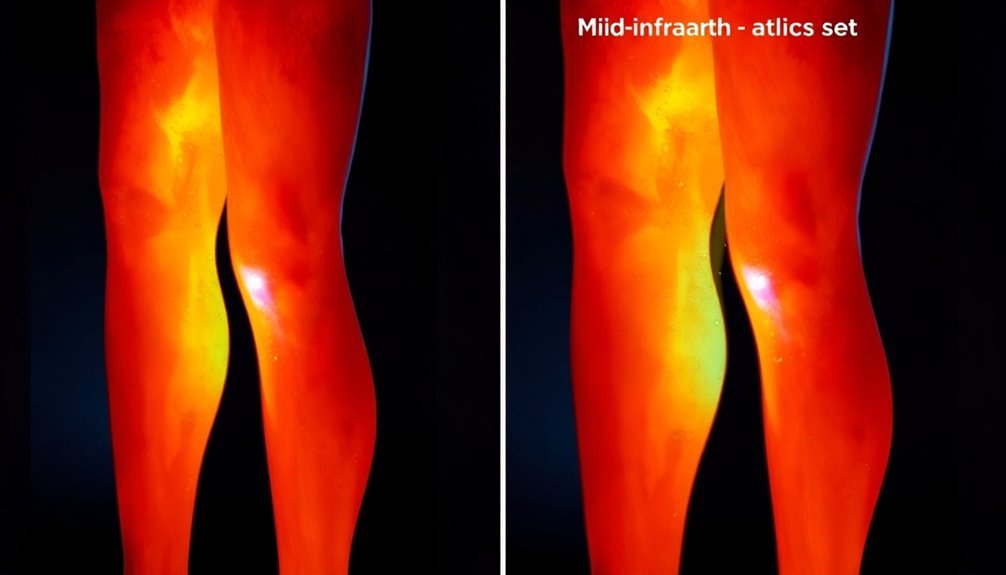
When inflammation strikes your muscles after intense exercise or injury, infrared therapy steps in as a powerful modulator of your body's inflammatory response. It works by targeting specific cellular pathways that control inflammation, reducing pro-inflammatory markers like IL-6 and TNF-α while boosting your body's natural anti-inflammatory mechanisms. Research shows that 10-minute infrared exposures can effectively reduce inflammation through TLR4-dependent pathways.
| Inflammatory Factor | Infrared Therapy's Effect |
|---|---|
| Pro-inflammatory Cytokines | Decreases IL-6, IL-8, TNF-α levels |
| NF-κB Activity | Reduces activation and expression |
| Nitric Oxide Production | Increases, improving blood flow |
Your body's healing response becomes more efficient as infrared light penetrates deep into your muscle tissue. It triggers controlled oxidative bursts in your mitochondria, which might sound counterintuitive but actually leads to regenerative effects. The therapy also activates the Nrf2 pathway, a vital regulator of inflammatory responses, while simultaneously enhancing blood circulation to deliver oxygen and nutrients to damaged areas.
Recovery Time Optimization
You'll maximize your workout results by using infrared therapy 10-15 minutes before exercise to prime your muscles and boost ATP production.
After your workout, applying infrared therapy within the first hour helps accelerate recovery by reducing inflammation and muscle damage. Regular sessions enhance overall athletic performance through improved blood circulation and oxygen delivery to tissues.
To get the most benefit, schedule 20-30 minute treatment sessions, adjusting the duration based on your training intensity and recovery needs.
Pre-Workout Timing Benefits
Timing your infrared therapy sessions before workouts can dramatically optimize recovery and enhance overall performance. When you use infrared therapy for 3-10 minutes before exercising, you're effectively pre-conditioning your muscles to handle the upcoming stress while reducing potential damage and inflammation. The non-invasive treatment can be safely incorporated into your daily fitness routine without any harmful side effects.
Pre-workout infrared therapy boosts your endurance and fighting fatigue by increasing oxygen uptake and ATP production in your cells. You'll notice you can work out longer and more effectively, while your muscles recover faster due to reduced oxidative stress.
The therapy enhances blood circulation, properly warming up your muscles and substantially lowering your risk of injury.
- Pre-conditions muscles by increasing blood flow and reducing strain during exercise
- Enhances muscle activation for improved strength and endurance performance
- Accelerates healing processes and reduces inflammation before it starts
- Shifts your metabolic processes to optimize recovery and performance
For the best results, aim to use infrared therapy 3-5 times per week, targeting the major muscle groups you'll be working on that day. Consistency in your pre-workout therapy routine, combined with proper nutrition and rest, will maximize your fitness outcomes and recovery benefits.
Post-Exercise Recovery Windows
Maximizing your post-exercise recovery window is essential for ideal muscle repair and performance gains. The first 30 minutes after your workout represent a critical glycogen window when your muscles are most receptive to nutrients. During this time, your body experiences heightened insulin sensitivity, allowing for rapid glucose uptake into muscle cells. Consistent attention to proper refueling timing can help prevent diminished performance in future workouts.
You'll want to take advantage of this window by combining infrared therapy with proper nutrition. Your muscles are primed for recovery during this period, and infrared light can enhance the process by boosting circulation and cellular energy production.
| Time Window | Recovery Focus | Action Steps |
|---|---|---|
| 0-30 min | Glycogen Replenishment | Consume carbs + protein |
| 30-60 min | Inflammation Control | Apply infrared therapy |
| 1-2 hours | Active Recovery | Light movement/stretching |
| 2-4 hours | Tissue Repair | Hydration + rest |
| 4-24 hours | Complete Recovery | Quality sleep |
If you delay your recovery efforts beyond the initial window, you'll experience reduced blood flow and diminished nutrient uptake. Combining infrared therapy with proper timing can substantially accelerate your muscle recovery, reduce soreness, and prepare you for your next training session.
Optimal Treatment Duration Plans
Building on the importance of recovery windows, creating an ideal treatment duration plan helps maximize the benefits of infrared therapy.
You'll need to adjust your sessions based on your specific goals and recovery needs, with most treatments ranging from 5-30 minutes per muscle group. For general recovery, aim to schedule 3-4 sessions weekly, while intensive recovery might require daily treatments.
Position yourself 6-12 inches from the light source to facilitate maximum penetration, and always start with shorter durations to assess your body's response.
When using infrared therapy for pre-workout preparation, limit sessions to 5-10 minutes per muscle group. Post-workout recovery benefits most from 10-20 minute sessions, while injury rehabilitation may require longer 15-30 minute treatments.
- Pre-workout sessions boost performance and prepare muscles for exercise
- Post-workout treatments accelerate recovery and reduce inflammation
- Injury rehabilitation requires longer, more focused sessions
- Daily treatments can enhance results during intensive recovery periods
Remember to stay hydrated and follow your healthcare provider's recommendations, especially when treating specific conditions like arthritis or fibromyalgia. High-powered devices may require shorter treatment times due to deeper penetration capabilities.
Athletic Performance Enhancement

Athletes seeking a competitive edge have discovered a powerful ally in infrared therapy for enhancing performance. Through its ability to boost strength, increase power output, and improve neuromuscular function, infrared therapy delivers measurable advantages during intensive training periods.
You'll experience enhanced athletic performance through multiple mechanisms. The therapy stimulates your mitochondria, increasing energy production at the cellular level, while improving oxygen delivery to your muscles.
This combination leads to better endurance and higher peak power during workouts. You'll also benefit from an improved testosterone-to-cortisol ratio, which supports both recovery and performance gains.
Research on power athletes shows that infrared therapy can help you train harder and develop faster. It's been proven to increase peak VO2 and exercise tolerance over time, allowing you to push your limits more effectively.
The therapy's ability to enhance oxygen uptake and delay time-to-exhaustion means you can maintain peak performance for longer periods. Additionally, by promoting muscle stem cell development and reducing oxidative stress, infrared therapy helps you build and maintain muscle mass more efficiently, contributing to sustained performance improvements over time.
Muscle Soreness Relief
When muscle soreness sets in after intense training, infrared therapy offers powerful relief through multiple biological pathways. You'll experience a significant 55-60% reduction in muscle soreness as infrared light penetrates deep into your tissue, triggering increased blood flow and reducing lactic acid buildup.
The therapy's ability to boost circulation means more oxygen and nutrients reach your damaged muscles, accelerating the natural healing process.
- Reduces peak plasma creatine kinase activity by 45-89%, indicating less muscle damage
- Stimulates nitric oxide production, helping your arteries relax for better blood flow
- Triggers endorphin release for natural pain relief without medication
- Enhances ATP production in your cells, speeding up muscle repair
You'll find that infrared therapy works better than traditional Finnish saunas for neuromuscular recovery, getting you back to baseline 1-3 days faster. The treatment's analgesic effects provide immediate comfort while addressing the root causes of soreness.
Whether you're using far infrared sauna sessions or targeted light therapy, you're tapping into a scientifically-proven method that helps your muscles recover more efficiently through enhanced cellular repair and reduced inflammation.
Optimal Treatment Protocols

Success in infrared therapy depends heavily on following precise treatment protocols tailored to your recovery needs. You'll want to schedule sessions lasting 10-20 minutes per muscle group for general recovery, while injury rehabilitation requires longer sessions of 15-30 minutes, performed 3-4 times weekly.
For the best results, you'll need to position yourself 6-12 inches from the device, ensuring you're using the right wavelength range. Red light (630-700 nm) works for surface-level treatment, while near-infrared light (700-1200 nm) penetrates deeper into muscle tissue.
If you're planning pre-workout sessions, schedule them 3-6 hours before training to maximize benefits.
Your treatment frequency should match your recovery needs. For general maintenance, aim for 3-4 sessions weekly, but you can increase to daily sessions during intensive training periods. Choose a high-powered device that offers adjustable intensity levels and adequate coverage for your target areas.
While longer sessions can enhance benefits, don't exceed recommended durations, as this could diminish effectiveness. Remember, consistency in your treatment schedule is essential – regular, properly timed sessions will deliver the best results for muscle recovery.
Pre-Workout Preparation Benefits
If you're looking to maximize your workout, using infrared therapy before exercise can prepare your body at the cellular level by boosting ATP production readiness.
Your muscles will be primed for ideal energy utilization during training, which can lead to more effective workouts and reduced fatigue.
The gentle warming effect also acts as a pre-workout warmup, helping to prevent injuries by increasing tissue flexibility and improving blood flow before you begin your exercise routine.
Enhanced ATP Production Readiness
The cellular powerhouse within your muscles springs into action through pre-workout red light therapy, enhancing ATP production before intense exercise. When you expose your muscles to red light before training, your mitochondria become primed to generate more ATP, the essential energy currency your cells need for peak performance.
Your body's improved ATP production readiness creates several key advantages for your workout session:
- You'll experience increased muscle strength and endurance as your cells maintain higher energy levels throughout your training
- Your muscles will be better prepared to handle intense exercise, reducing the risk of strain and damage
- You'll notice less fatigue during your workout due to improved cellular energy efficiency
- Your post-workout recovery will accelerate thanks to the pre-activated ATP production mechanisms
Red and near-infrared light penetrates deep into your muscle tissue, stimulating blood flow and reducing oxidative stress before you even begin exercising.
This preconditioning effect means your muscles are already operating at a superior level when you start your workout, with enhanced protein synthesis capabilities and reduced inflammation responses ready to support your training goals.
Injury Prevention Through Warmup
Preparing your muscles with infrared therapy during warm-up sessions creates a powerful shield against workout-related injuries. The heat dilates your blood vessels, increasing circulation and oxygen delivery to muscle tissues, while elevating muscle temperature for enhanced elasticity. This combination substantially reduces your risk of tears and strains during exercise.
When you warm up with infrared therapy, you'll experience improved range of motion through dynamic stretching, making your movements more fluid and controlled. The heat activates your nervous system, sharpening proprioception and enhancing muscle coordination, which helps prevent sudden, uncoordinated movements that often lead to injury.
You'll also benefit from the psychological aspects of infrared warm-ups. The process allows you to mentally prepare for your workout while managing physical and emotional stress levels. This mental readiness, combined with enhanced neural feedback, helps you maintain proper form and technique throughout your exercise routine.
For the best results, tailor your infrared warm-up intensity to match your planned activity. Be mindful not to overdo it – moderate exposure is key to preventing fatigue while maximizing the protective benefits of increased circulation and muscle flexibility.
Post-Exercise Recovery Strategies
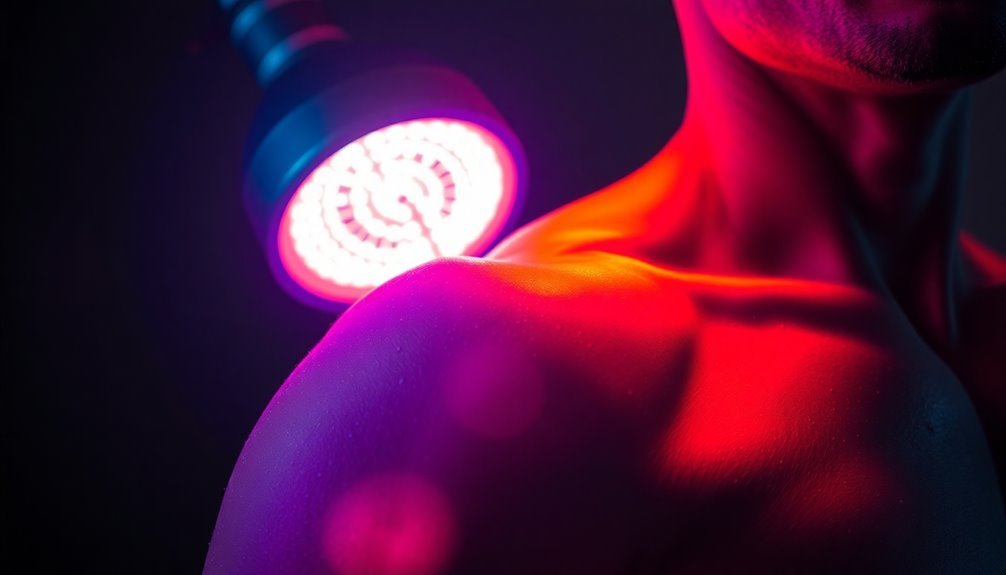
During intense physical training, your body undergoes significant stress that requires proper recovery strategies to maintain performance and prevent injury. The key to effective recovery lies in implementing a thorough approach that combines nutrition, active recovery, and advanced therapeutic techniques.
Your post-exercise recovery should start within 30 minutes of finishing your workout. You'll need to consume 20-30 grams of protein along with carbohydrates to replenish glycogen stores and support muscle repair.
Don't forget to rehydrate by drinking 2-3 cups of water for every pound lost during exercise.
Essential recovery strategies you should implement:
- Perform 5-10 minutes of cool-down exercises to gradually decrease your heart rate
- Use foam rolling or massage techniques to boost circulation and reduce muscle tension
- Get 7-9 hours of quality sleep to support physical and mental recovery
- Incorporate advanced techniques like infrared therapy to enhance blood flow and reduce inflammation
Frequently Asked Questions
Can Infrared Therapy Help With Old, Chronic Muscle Injuries?
Yes, infrared therapy can help your old muscle injuries by boosting healing, reducing pain, and improving blood flow. You'll see better results when you combine it with traditional treatments under professional guidance.
Is Infrared Therapy Safe to Use During Pregnancy?
You shouldn't use infrared therapy during pregnancy without consulting your doctor. It's generally not recommended due to potential risks of overheating, which could harm your baby. Consider safer alternatives like gentle massage instead.
How Does Infrared Therapy Interact With Muscle-Building Supplements?
Infrared therapy can enhance your muscle-building supplements' effectiveness by improving circulation, boosting nutrient delivery, and increasing ATP production. You'll experience better absorption of supplements and faster muscle recovery when combining both treatments.
Can You Combine Infrared Therapy With Other Recovery Methods Like Cryotherapy?
Yes, you can combine infrared therapy with other recovery methods, but it's best to avoid using cryotherapy together since they have opposing effects. Instead, pair it with stretching, massage, or PEMF therapy for best results.
Does Skin Color or Body Composition Affect Infrared Therapy Effectiveness?
Yes, both factors affect treatment. You'll need higher doses if you have darker skin or thicker tissue, as they reduce infrared light penetration. Your therapist should adjust settings based on your individual characteristics.
In Summary
You'll find that infrared therapy accelerates muscle recovery through multiple mechanisms. It increases blood flow, boosts mitochondrial energy production, and reduces inflammation in your damaged tissues. When you're consistent with treatments before and after workouts, you can expect faster healing times and less muscle soreness. Incorporating infrared therapy into your fitness routine isn't just trendy – it's backed by science for enhanced recovery results.

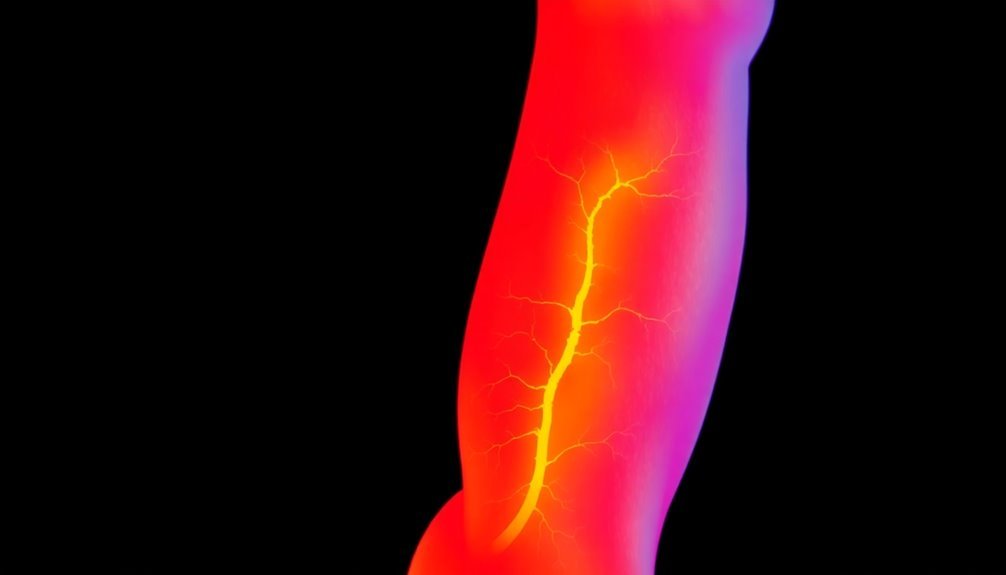



Leave a Reply